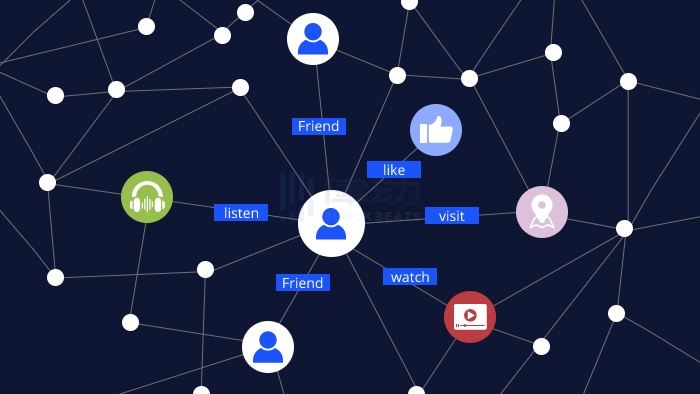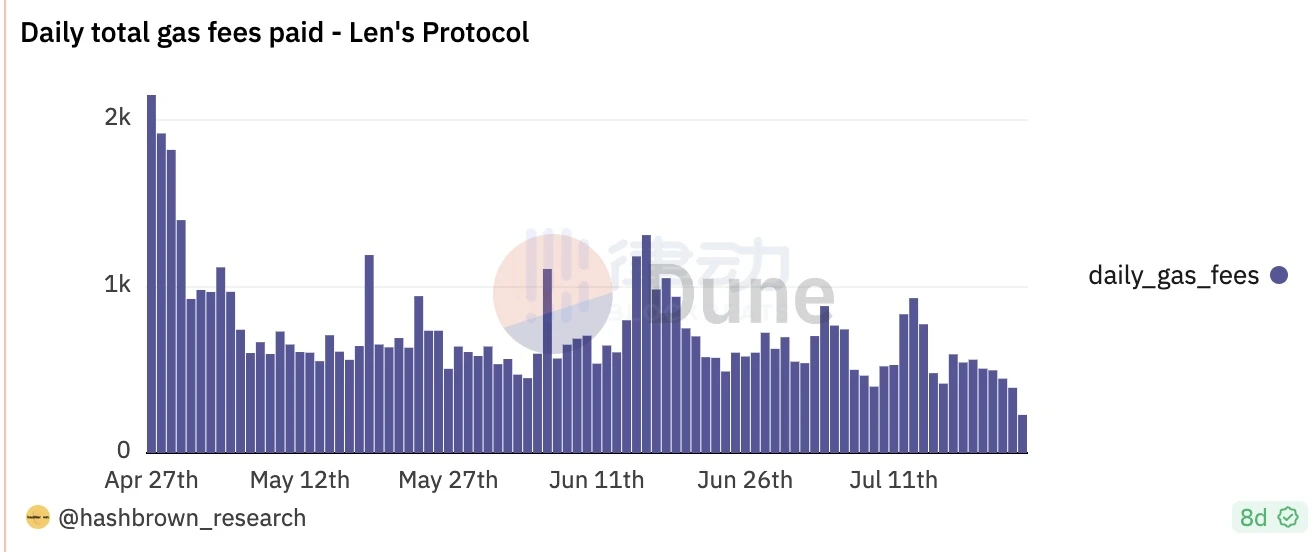
Web2 is the era of platformization, where code, databases hosting user personal data, and user communication information are all hosted under the same entity. Web3 fundamentally differs from Web2 in its underlying architecture, where all these functionalities are decoupled. User personal data, data storage, and direct messaging (DM) are supported by different protocols. Furthermore, its permissionless openness and composability support third-party developers to build any usable applications and create new user experiences, contributing to the ecosystem.
Lens Protocol is a Web3 social graph protocol built on Polygon. As one of the important replacements for Web2 social media platforms, it adopts an open decentralized underlying architecture, which has quickly formed a thriving ecosystem. In addition to applications developed by the project itself, numerous third-party applications and several compatible decentralized social technology stacks have emerged.
Fundamentally, this is thanks to the inherent "permissionless openness and composability" of blockchain, which means developers can build any usable applications without permission, not just relying on core developers. All social media technology stacks, including Lens Protocol, can be used by developers to build any decentralized applications without permission.
So, besides Lens Protocol, what other decentralized technology stacks are available? This article lists a series of technology stacks that can be used to build Web3 social applications. BlockBeats believes that as a leading Web3 protocol, Lens Protocol founder Stani's decentralized technology stack is highly representative. It is worth noting that due to the rapid development progress of Web3, this article does not comprehensively cover all decentralized social-related technology stacks.
Huddle01
One-click meetings. Use Web3 login to create token-supported spaces, supporting NFT avatars and decentralized storage.
Livepeer
Livepeer is a decentralized video transcoding service that connects applications needing video transcoding services with nodes (coordinators) that perform transcoding.
Livepeer provides decentralized video encoding services. For example, in the Lens application Lenstube, when users upload videos to their channels, these videos can be watched as streaming videos supported by Livepeer and permanently stored on the Arweave blockchain.
XMTP
XMTP is a universal Web3 communication protocol and network that supports end-to-end encrypted communication between on-chain addresses. Developers can integrate the XMTP SDK into dApps without permission to enable in-app DM and notification functionality. By integrating the XMTP protocol, Lens provides users with portable DM tools and interoperability with other decentralized applications that have joined the XMTP protocol, enabling cross-app chat.
For example, Lens users can chat and send assets within their respective applications with Coinbase Wallet users who have also integrated the XMTP protocol, and can even search for Lens handles in the Coinbase Wallet to send messages and encrypted assets directly.
Related reading: "In-depth analysis of the decentralized business potential behind Coinbase Wallet's new feature: XMTP"
Sismo
Sismo is a modular proof protocol deployed on Polygon, focusing on decentralization, privacy, and practicality, issuing proofs in the form of badges (non-transferable tokens/SBT), which users can mint on their applications.
Lit Protocol
Enabling "restricted access content on an open social graph while maintaining composability" is a major challenge.
By using Lit Protocol, Lens Protocol can "encrypt content posted on Lens Protocol and enable token-controlled access permissions," meaning that encrypted content can be decrypted and viewed in any application as long as the user has access permissions (which can be achieved through NFT gating).
This can enable various functions, including but not limited to:
- Private personal profiles
- Private posts
- Paid unlockable posts
- Token-controlled access permission posts
- Token-controlled file download permissions.
Applications can store all encrypted information in the metadata of each posted content, and this content can be decoded in any Lens application that has deployed the Lit SDK.
Gelato Network
Gelato Network is a Web3 decentralized backend solution that supports builders in creating automated, gas-free applications. Its multi-chain transaction API Gelato Relay provides services such as gas-free transactions, custom bots, cross-chain bridges, and cross-chain messaging protocols, helping Web3 application and infrastructure developers use simple APIs to facilitate rapid transactions for their users or protocols.
The Koru DAO account on Lens is a decentralized autonomous organization controlled by multiple people, built using the Gelato Network's customized execution API Gelato Relay. All 282 Koru NFT holders can post on Lenster on behalf of the Koru DAO, and all these interactions do not require payment of gas fees.
RedStone Oracles
RedStone generates user credit scores for individual accounts on Lens Protocol, with each Lens Protocol user receiving a corresponding credit score called LensScore.
LensScore is calculated based on the following 6 metrics retrieved from the GraphQL API:
- Comments * 0.25
- Posts * 0.5
- Publications * 0.5
- Followers * 0.75
- Favorites * 1
- Mirrors * 1
It is noteworthy that each metric has a different weight, with Favorites and Mirrors having the highest weight.
The goal of LensScore is to quantify the activity and engagement of Lens users on the social platform, differentiating between bot and human interactions. This credit score can also be applied to future undercollateralized lending scenarios. Finally, LensScore can be used for "lazy" KYC verification for airdrops/whitelists, allowing users to remain anonymous while proving they are not bots.
Karma3 and Airstack
The strength of Web3 social protocols like Lens lies in the fact that all data and interaction history are public, allowing developers and teams to build their own custom recommendation and ranking algorithms based on on-chain data.
In addition to the Lens team's own Lens GraphQL API, Lens also supports developers to call other API recommendation algorithms, including Karma3 and Airstack.
Karma3 is an open protocol that supports developers in planning ranking and recommendation systems for their applications based on on-chain data, providing personalized search, discovery, and recommendations for applications on the Lens protocol. All profiles in the Lens ecosystem are scored and ranked hourly, and these scores and rankings are provided through different APIs that clients can call as needed. These APIs are based on 4 different scoring strategies: following, engaging, influencing, and creating.
Airstack supports users in accessing general on-chain transactions, specific dapp events, and NFT market data, as well as querying and combining on-chain and off-chain data simultaneously. Using GraphQL, Airstack allows users to retrieve only the necessary data in a single query, rather than predefined datasets returned by traditional REST endpoints.
Airstack provides a universal resolver that allows users to resolve or reverse-resolve Lens Profiles to other Web3 identities (Farcaster, ENS, Ethereum addresses). For example, users can retrieve Lens profiles from specific users, as well as retrieve Ethereum addresses, Farcaster, and ENS from Lens profiles.
The Identity API provided by Airstack allows users to query, aggregate, and transact on-chain data using Lens profiles.
Snapshot
Snapshot is a decentralized voting system that provides users with efficient, low-cost, decentralized voting tools. Lens SDK version 1.2 integrates the Snapshot voting system, supporting Lens application developers to integrate Snapshot voting into their own applications.
Arweave and Bundlr Network: Content Data Availability and Fast DA Upload
The Data Availability (DA) layer is mainly used to avoid storing data on-chain by pointing on-chain resources to existing data availability locations (storage) to reduce costs. In practice, Data Availability layers are a convenient way to extend information to on-chain properties (e.g., NFTs) without storing data on-chain.
The content data availability (DA) on Lens Protocol is provided by Arweave.
Considering the possibility of reaching peak TPS of 25,000 on social media, Lens Protocol launched the blockchain social media application expansion solution Momoka in April this year, which uses Bundlr as the infrastructure for storing large files and related verification data.
As an Optimistic L3 expansion solution, Momoka processes Polygon transactions off-chain to achieve large-scale transactions and reduce transaction costs.
Unlike most L2 solutions, Momoka does not compress multiple L2 transactions into L1, but sends several transactions to the data availability layer to optimize costs and achieve higher scalability required by social media networks, avoiding limitations of block space or block time configurations.
For Lens users, higher security levels are needed for personal profiles, while a more lightweight Data Availability (DA) infrastructure layer may be a more feasible solution for social comments and other network data. Momoka is a network used to process and store social media posts, comments, and shares, serving as a second-layer storage data on the Polygon network to improve Lens scalability.
However, using Momoka is still optional. For developers, they can continue to store all content on Polygon, and an alternative approach is for submitters to pay for the storage of DA metadata on Arweave through Bundlr, reducing costs by 1000 times compared to executing EVM transactions.
Data shows that since its launch in April, Momoka has significantly reduced transaction costs for Lens and improved Lens stability, with a nearly 90% decrease in transaction failure rates in May.

Reference links:
https://twitter.com/jaencarrodine/status/1592630356166836225
https://twitter.com/redstone_defi/status/1568165561414336516
https://www.gelato.network/blog/introducing-koru-dao
https://dune.com/hashbrown_research/momoka-effects-on-lens-protocol
https://docs.lens.xyz/docs/other-apis-and-algorithms
https://twitter.com/StaniKulechov/status/1677778496439873542
免责声明:本文章仅代表作者个人观点,不代表本平台的立场和观点。本文章仅供信息分享,不构成对任何人的任何投资建议。用户与作者之间的任何争议,与本平台无关。如网页中刊载的文章或图片涉及侵权,请提供相关的权利证明和身份证明发送邮件到support@aicoin.com,本平台相关工作人员将会进行核查。




